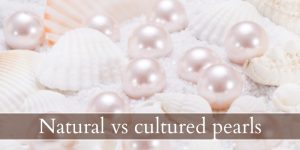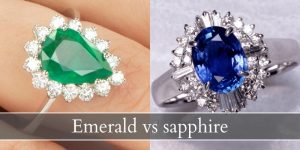Emeralds have always been regarded as the green gem to top all green gems. There are shades of green named after emerald, and these gems have fascinated people for thousands of years. But one gem seems to want to compete with emeralds, and that is green diamond. While diamonds are most known for white and perfectly clear, they do come in several colors (called fancy diamonds).
And it just so happens that green diamonds really give emeralds a run for their money. Just how much ? Well, let’s take a look at green diamonds vs emeralds, and see just how much hey differ. You might be surprised which one catches your eye !

Green diamond vs emerald
Green diamonds are far tougher than emeralds, and offer more better clarity and sparkle than an emerald. Emeralds are a more vibrant green and green diamonds have a hard time matching the color of an emerald exactly. Even so, fine green diamonds are about 27 times more expensive than the finest emerald, so you should be prepared.
Overall both green diamonds and emeralds offer a nice green gemstone, but they do so very differently. A green diamond is impressive on its own, through its sparkle and clarity. Emeralds are impressive through their intense color and the prestige that comes with owning such an ancient gemstone.
What are emeralds ?
Emeralds are a type of beryl, the most famous beryl there is. Other names you may have heard of are morganite (light pink-orange) and aquamarine (light icy blue), both in the beryl family. Emeralds owe their green to trace amounts of chromium, and in some rare cases vanadium.
What are green diamonds ?
Green diamonds are a type of diamond that shows a specific color, in this case green. Colored diamonds are known as fancy diamonds, and green ones can be very similar to a very fine quality emerald at first glance. A green diamond owes its green hue to irradiation deep within the Earth’s bowels when the diamond first formed. As time went on that radiation has lowered, but the color remains.
Read also: Pink Sapphire VS Morganite
1. Green diamonds still have a lot of sparkle to them, emeralds don’t
Perhaps the first thing that gives away a green diamond trying to pass for an emerald is its sparkle. Even with its green color, a green diamond is still capable of reflecting a rainbow at you, even if a bit less than a clear/white diamond. This is mostly due to the high refractive index of a diamond (2.42), which is far greater than an emerald (1.56).
So, an emerald won’t be able to reflect a rainbow or even white flashes. It can give you some green flashes, but it’s nowhere near as glittery as a green diamond. And in a way, that’s great because it does not detract from the emerald’s amazing green color. It’s still a very good point to keep in mind when wondering which green gem you’d like better.
2. Emeralds have a vivid green color, green diamonds vary
Speaking of green color, emeralds and green diamonds offer a green hue but in a very different way. Emeralds are green all around, and throughout their entire crystal. Emeralds are green because their body is green. If you hold one up to the light and turn it in every angle it will still look green throughout.
A green diamond doesn’t have as much of a green body, but more of a clear body with microscopic inclusions that make it appear green when viewed from the right angle. If you take a green diamond and turn it in your hand, you will notice in some angles it looks clear, and in some it looks very green. This is simply the way fancy colored diamonds are. You can find very vivid green diamonds with more green to their body but those are incredibly rare.
There is also a significant color difference between emeralds and green diamonds. Emeralds have a deep, vivid green with a very slight blue tone to them. They can be less saturated but the color is still there. Green diamonds vary in hue and saturation a whole lot, from blue-green to grey-green to yellow-green to barely any hint of green, and in different intensities of green.
So, if you do intend to get a green diamond you should be very patient, or have a lot of cash as these diamonds sting.
3. Green diamonds are far tougher than emeralds
Perhaps one of the key points that made you consider an alternative to emeralds is their soft nature. An emerald scores a 7.5-8 on the Mohs scale of hardness, which is decent, but definitely not good for something you’d want to wear all day, every day. In time emeralds can get very cloudy due to accumulated scratches.
Green diamonds are still diamonds, and as such score a 19 out of 10 on the Mohs scale, which makes them impervious to anything except another diamond. So a green diamond will be a great option for jewelry worn every day, such as an engagement ring, or jewelry that may take a lot of hits like a tennis bracelet.
4. Emeralds are more affordable than green diamonds
Prices are very high, both with emeralds and with green diamonds. If these are the gems you’re looking to buy then you’ve likely mentally prepared for a high price. Still, the difference between green diamonds and emeralds may make you think twice about which to get.
Emeralds usually sell for $18,000 per carat and up, with a vivid green color and eye-clean clarity. An emerald that is even slightly included will have a lower price, and one that has been treated for clarity and is still a bit included is going to sell for even less. Not enough to save a fortune, but about half the price of a fine emerald, so about $7,000 per carat because the color is still very good.
Green diamonds usually sell for about $500,000 per carat, with a vivid color and minimal inclusion (like VVS1). Less color and a few inclusions can bring the price down quite a bit.
So in short even the most expensive heirloom-quality emerald is still worth less than a vivid green diamond, but they are two very, very different green gemstones.
5. Green diamonds are much less included than emeralds
Another way to tell an emerald from a green diamond, aside from specific color and sparkle, is the clarity. Emeralds are beryls and the only eye-clean beryls are morganite and aquamarine. So an emerald is often going to look a bit cloudy, much like an old timey mint hard candy would look. You can find eye-clean or just VVS1 emeralds, and those are the most expensive you could find.
Green diamonds are far clearer by comparison, even the slightly included ones.
Can you use an emerald instead of a green diamond ?
No, an emerald and a green diamond cannot be used in place of the other because their difference in sparkle and clarity would offer a very different looking gemstone. Even the most exceptionally clear emeralds can’t compete with a green diamond’s clarity and sparkle.
If all you’re looking for is a green gemstone, either one could work but the emerald will burn a much smaller hold in your pocket than a green diamond.
And if you’re looking for a green diamond substitute, and were thinking of emerald, a better option is green moissanite or green cubic zirconia. Or you could try a lab-grown green diamond, which would be about half the price of a natural green diamond.
Is emerald or green diamond better for an engagement ring ?
Green diamond is a better option for an engagement ring, because it is very tough and will hold up very well for centuries. This means you can easily pass it down generation after generation and the green diamond will still look brand-new. An emerald can still look good after several decades, because the stone itself does not decay on its own. But it must be treated with lots of love and care because emerald can accumulate scratches.
If you have an emerald that was passed down in your family it makes sense to want to gift it to your loved one. But please remember to take very good care of this gem, and maybe restrict it to formal events or just evening wear, so there are less chances of hurting the emerald. Or, you can re-set the emerald in a necklace, which is much safer than a ring.

I’m the main author for jewelrymaterialguide.com. I started this site after we did tons of research before our wedding and noticed that there is information about rings, jewelry, and so on that is really hard to find on the internet.






